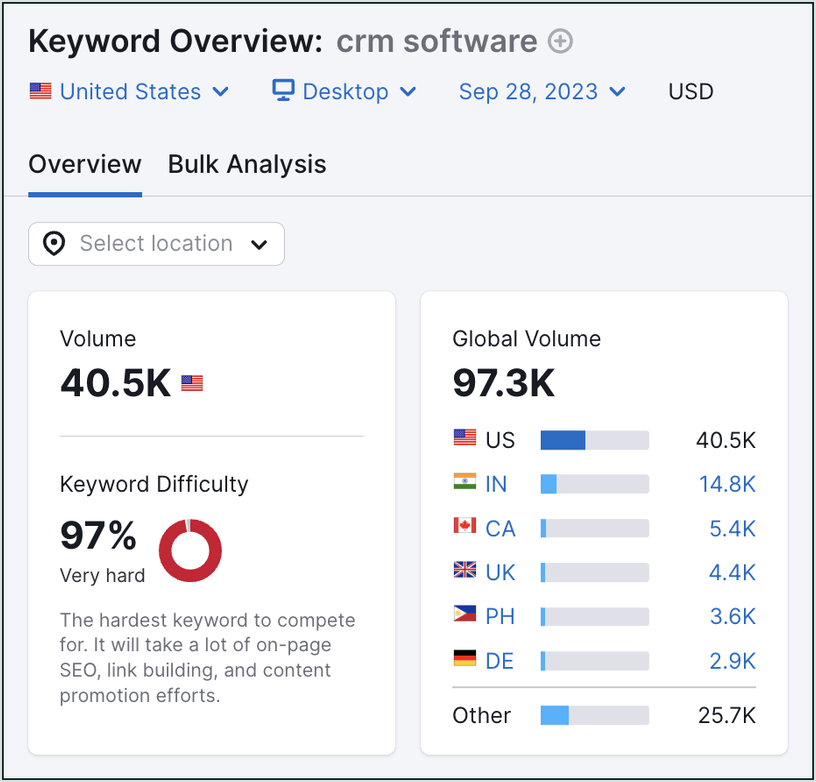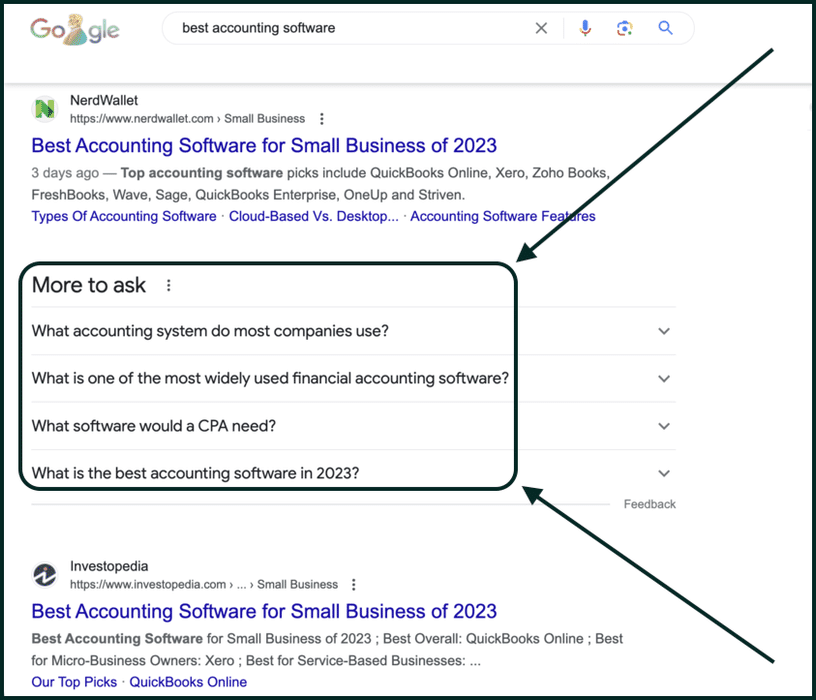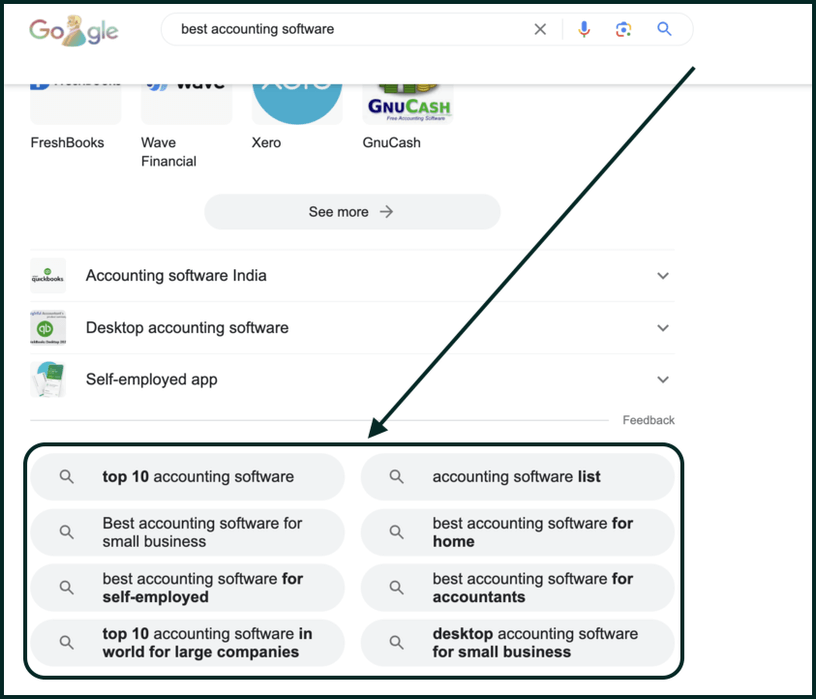- What Is SaaS SEO?
- A 5-Step SaaS SEO Framework
- SEO vs. PPC for SaaS Companies
Table of Contents
Today’s SaaS landscape is crowded, to say the least.
In the U.S. alone, there are:
- 9,000+ business intelligent software providers
- 1,700+ CRM system providers
- 1,300+ speech and voice recognition software providers
- 1,200+ payment processing software providers
- 400+ HR & payroll software providers
- 400+ website creation software providers
- 300+ point-of-sale software providers
- 100+ tax prep software providers
- 100+ identity management software providers
Don’t let those numbers scare you, though. Search engine optimization, or SEO, can help you gain visibility and stay competitive, no matter how saturated the market gets.
Keep reading our SaaS SEO guide to learn more.
What Is SaaS SEO?
SEO is a type of digital marketing that revolves around the goal of getting websites to rank higher in search engines for specific terms.
An effective SEO campaign could ensure that your website is the first non-sponsored listing a person sees when they Google a term like “CRM software.”
Why is this valuable?
Because the term “CRM software” gets searched 97,000+ times a month.

And the top three results on Google get 54.4% of the clicks.
Many of the people who type “CRM software” into Google are probably looking to buy CRM software, this traffic would be huge for your business.
Wait, can I really rank for a competitive term like ‘CRM software’? Isn’t that difficult?
Great questions! Let me answer them one at a time:
- Yes, you have the opportunity to rank for a competitive term like “CRM software.”
- Yes, it is difficult.
That said, you’ll be able to rank for less competitive keywords much faster.
Niche-specific search terms like “construction CRM software” and “B2B CRM software” are much less competitive but could still drive thousands of visitors to your site every month.
Plus, ranking for several of those less competitive terms creates a snowball effect of sorts — the more you rank for, the better chance you’ll have at ranking for more competitive terms.
A 5-Step SaaS SEO Framework
Every SEO campaign looks different, but here’s a general framework that can help SaaS companies rank for their target keywords and attract leads from search engines.
- Fix any technical issues that could hinder website performance
- Build a keyword strategy around your audience’s interests and pain points
- Create search-optimized content that showcases your expertise
- Promote content to help build backlinks
- Track, measure, and improve content for better performance
Let’s walk through each of these steps, and I’ll briefly explain what that step looks like in action.
1. Fix Any Technical Issues That Could Hinder Your Search Performance
Here are some back-end website issues that can affect your site’s SEO performance:
- Unwanted ‘noindex’ directives that prevent your pages from appearing in searches
- Incorrect rel=canonical tags that lead to the wrong page appearing in searches
- Slow-loading pages that don’t perform well in searches (Google tends to reward faster sites)
Even the highest quality content won’t help you if your site has any of these issues, so it’s best to address them ASAP.
Technical SEO for SaaS Companies
These tasks fall under the category of technical SEO, and they’re crucial to a solid SaaS SEO strategy:
- Make sure you have a secure URL.
- Modify your robots.txt file to tell search engines like Google which pages to crawl or not.
- Remove any ‘noindex’ directives that could prevent search engines from including your site in searches.
- Install a plugin like Imagify to compress all of the images on your site.
- Delete any duplicate content or use ‘rel=canonical’ tags to identify the “original”.
- Build an XML sitemap to help Google analyze and index your site.
- Fix any broken links to ensure Google can crawl your site properly.
- Remove redirect chains to improve site loading times.
- Use ‘hreflang’ tags to send users to pages in their language.
If you’re looking for a tool that can help you to identify technical issues, SEMRush is very helpful. Its Site Audit feature flags any errors that could affect your site’s SEO performance.
I discuss some other helpful SEO platforms in this article: 14 DIY SEO Tools to Help You Scale Your Business.
2. Build a Keyword Strategy Around Your Audience’s Interests
When building your content strategy, you’ll have to decide which searches are most valuable for your site to appear in.
Let’s say you make an accounting SaaS product. You’d obviously want to appear in searches related to accounting software, like “best accounting software, “cloud accounting software,” or “small business accounting software.”
However, your future customers might not even know that they need accounting software.
You can connect with these customers by targeting search terms related to their interests and problems.
For instance, ranking for a keyword like “how to manage business expenses” could get your brand name in front of people who have the problem that your product solves. You can create a piece of content around this term that offers some expense management tips and shows your customers how your product, specifically, can help.
Note: Not all of your content has to relate directly to your product or the problem it solves. Remember, we’re looking for visibility just as much as leads.
If you can rank for terms that are one degree removed from your product (e.g. “how to write a business plan” for an accounting software company), you can attract a lot of people to your website who are interested in topics related to your business.
(Plus, some of those people might need your product at some point in their careers).
How to Find Keywords for a SaaS SEO Strategy
The easiest way to find keywords is to use SEO software like SEMRush or Ahrefs. They both provide detailed data about search terms, including monthly search volumes and “difficulty scores.”
If you don’t have access to SEO software, here are some free keyword research tactics you can use:
- Competitive research: Google your competitors and look at the terms they use in their meta titles. Look at their blog content, too; they probably use their target terms in their blog titles.
- Audience research: Go to the communities where your target customers hang out online (LinkedIn, Slack, Reddit) and look at the questions they ask there. Boil those questions down to their simplest form (e.g. “how to choose accounting software”), and use those terms as your targets.
- Google research: Go to Google and search for a term that you know you want to rank for (e.g. “best accounting software”). Look at the More to Ask and Related searches sections (seen below). If you think you could create some valuable content around that topic/question, add them to your strategy.


3. Create Search-Optimized Content Showcasing Your Expertise
Blogging is an effective SEO tactic because it can drive a lot of organic traffic to your SaaS website. It allows you to answer the questions that your target audience is asking online and to establish yourself as an expert source of information (which, in turn, drives even more traffic).
Writing SEO content can get tricky because it’s easy to start writing for search engines rather than human readers. Don’t do that; always keep your living, breathing audience in mind.
But, there are some steps you should take to help Google understand what your page is about so that it can properly index your page. Here are a few examples:
- Include the page’s target keyword in your meta title and page title.
- Keep your meta titles under 600 pixels wide (use this tool to help you).
- Structure your subheadings as questions or common queries to make them more “searchable.”
- Optimize your paragraphs for Featured Snippets by making them less than 100 words and being sure to answer the question in your header.
- Incorporate long-tail keywords to help you rank in niche, low-competition searches.
- Include internal links to help Google understand how your page relates to other pages on your site.
Above all, make sure that your content satisfies the search intent of your target. In other words, ask yourself:
Why did the searcher type these words into Google? Does my content deliver what they’re looking for?
And, more importantly:
Does my page do a better job at satisfying the search intent than the other pages that currently rank?
4. Promote Content to Help Build Backlinks
Backlinks are high up on the list of Google’s ranking factors, which are the criteria they use to determine search rankings.
Google assumes that pages with a lot of links must be high-quality resources, because why would people link to them otherwise?
The most effective link-building strategy is to create content that’s so helpful that it generates backlinks just by living on your website. That’s the case with our 45 SEO Statistics article, which frequently gets cited as a reference by bloggers and journalists.
It can take time for a piece of content to become visible enough that it starts to drive backlinks, though.
In the meantime, I recommend taking some steps to build links to your site.
There are a few ways to do this, but my favorite tactic is to use a platform like HARO or Help a B2B Writer. Writers use these platforms to source expert quotes for their own content, and they’re good tools for building up your domain’s reputation.
Find some helpful tips for getting here: How to Write an Effective HARO Pitch
5. Track, Measure, and Improve Content for Better Performance
![]()
The benefit of SEO is that you can measure it in real time and adjust your campaign as necessary.
For example, if your page’s clickthrough rate doesn’t match up with its keyword rankings, you might need to try a new meta title. If you know how to use Google Search Console, our SERP CTR tool can help you to identify and improve any underperforming meta titles.
It’s a never-ending game of trying to improve and maintain page rankings.
There’s no shortage of SEO measurement tools, but I’d recommend using Google Analytics and Search Console, at the very least.
You probably have Analytics set up already, but Search Console will help you track a lot of SEO-specific metrics (keyword positions, search impressions, click-through rate, etc.).
SEO vs. PPC for SaaS Companies
Can’t I just buy Google ads if I want to rank at the top of Google?
We get this question all the time.
And while the answer is that yes, buying pay-per-click (PPC) could technically put you at the top of Google, SEO is a better long-term strategy.
Google Ads only have a 6.11% click-through rate (CTR). A page that ranks at the top of the organic search results sees a 28.6% CTR, on average (as of 2023).
Over time, this leads to a higher ROI from SEO than from PPC.
Read this case study to learn how we helped one SaaS startup grow sign-ups by 82.8%.
Good SEO Grows SaaS Businesses
Search engines are a channel where you have the opportunity to outperform your biggest competitors, even if those competitors are more established than you.
That’s why SEO is a crucial part of any SaaS content marketing strategy.
Looking for an SEO partner to help you grow your sales? We’d love to chat!
Learn all about our SEO consulting and content marketing services here.
SCALE YOUR ORGANIC TRAFFIC
Subscribe to our monthly newsletter




